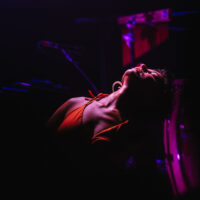Biographie
Rui Paixão est un clown du pire genre.
Créateur et interprète passionné par les espaces publics, il se spécialise dans le théâtre physique, le clown et le cirque contemporain. Fort d’une expérience internationale, il a travaillé à deux reprises avec le Cirque du Soleil et collabore en tant qu’interprète avec la chorégraphe Marlene Monteiro Freitas. En 2022, il a pris la direction artistique du Circo do Coliseu do Porto, et depuis 2015, il est l’auteur de ses propres spectacles.
Parmi les grandes caractéristiques de son travail figurent la transformation, la transfiguration, l’exagération, l’improvisation et l’interaction avec le public.
Rui Paixão is a clown of the worst kind.
A creator and performer with a special interest in public spaces, he specializes in physical theatre, clown, and contemporary circus. With international experience, he has worked twice with Cirque du Soleil and collaborates as a performer with choreographer Marlene Monteiro Freitas. In 2022, he took on the artistic direction of the Circo do Coliseu do Porto, and since 2015, he has been the author of his own shows.
Some of the big characteristics of his work are transformation, transfiguration, exaggeration, improvisation and audience interaction.
Résidence — Funny Funny Bones
En tant que clown, j’ai souvent cherché à prendre de la distance par rapport à la simplicité de mon art, en y intégrant des thèmes plus lourds — politique, société, rôle de l’art — dans une tentative de prouver qu’un clown peut aussi penser, réfléchir et parler de ce qui importe. Mais aujourd’hui, j’éprouve le désir de créer ma première pièce sans masque. Autrement dit : ma première performance où j’accepte pleinement le destin qui m’a été donné — exister pour faire rire les autres.
Je suis guidé par la conviction que le rire peut se déclencher sans récit ni ces signaux artificiels que l’on trouve souvent dans la comédie — ces moments qui semblent indiquer au public : « C’est maintenant qu’il faut rire. » Mon but ultime est d’élargir les possibles d’un langage encore profondément lié à la tradition, et d’inviter le public à redécouvrir le clown — en tant que figure artistique vitale et contemporaine. Une provocation à la convivialité : sentir la présence des autres, se laisser toucher par le son du rire, lâcher prise, montrer les dents.
Rui Paixão construit une rencontre immersive où l’humour devient un outil de transformation. L’œuvre puise dans l’essence même du clown, tout en la présentant sous un prisme stylisé, minimaliste et profondément corporel — remettant en question les perceptions et invitant les spectateurs à un espace de libération émotionnelle et de catharsis collective.
As a clown, I’ve often tried to distance myself from the simplicity of my craft, bringing heavier themes into my work—politics, society, the role of art—in an attempt to prove that a clown can also think, reflect, and speak about what matters. But now, I find myself with the desire to create my first piece without a mask. In other words: my first performance where I fully accept the fate I’ve been given—to exist in order to make others laugh.
I’m guided by the belief that laughter can be triggered without narrative or the artificial cues that often appear in comedy—those moments that seem to inform the audience: “You’re supposed to laugh now.” Ultimately, I aim to expand the possibilities of a language still deeply bound to tradition, and to invite audiences to rediscover the clown—as a vital, contemporary artistic figure. A provocation toward togetherness: to feel the presence of others, to be affected by the sound of laughter, to let go of control, to show teeth.
Rui Paixão crafts an immersive encounter where humor becomes a tool for transformation. The work draws from the essence of clowning, yet presents it through a stylized, minimalist, and deeply physical lens—challenging perceptions and inviting viewers into a space of emotional release and collective catharsis.
![Programmes de résidence Kinski-RuiPaxao[o°]CollectifDesFlousFurieux-5](/wp-content/uploads/2023/03/kinski-ruipaxaoocollectifdesflousfurieux-5-200x200.jpg)

